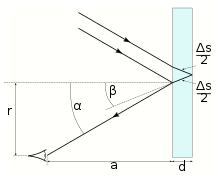Haidinger rings
When Haidinger rings is one of interference caused visual appearance. They are named after the Austrian geologist and mineralogist Wilhelm Karl Ritter von Haidinger . He first described this phenomenon in 1849.
The Haidinger rings arise when light from an extended light source falls on a plane-parallel plate . Then each beam of light is reflected from both the front and rear surfaces of the plate. The two reflections are shifted parallel to each other - except at a perpendicular angle of incidence - and have a path difference that creates the interference when both rays are focused on an image point of an object at infinity in an imaging lens , such as the eye. The position of the interference maxima is - with a homogeneous refractive index and constant thickness of the plate - dependent only on the viewing angle on the plate, therefore they appear ring-shaped with their center where the observer looks perpendicularly on the plate.
The same effect occurs if the interference occurs at an air gap between two plates, and also if a point light source and a flat screen are used instead of the extended light source and the point optics.
Formulas
Note: The representation takes place with the variant of an extended light source, a point optic and a plane-parallel plate. The formulas are analogous for the other cases.
The light that is reflected on the rear surface has to travel a wider optical path than that which is reflected on the front surface. This path difference results from the thickness of the plate , its refractive index and the angle at which the path of the light through the flap deviates from the perpendicular.
here is the angle to the perpendicular inside the plate, which results from the external angle of incidence using Snellius' law of refraction :
Therefore, the path difference results:
With an increasing angle of incidence , i.e. increasing distance from the perpendicular , this path difference becomes greater and greater. It is plumb , and every time it exceeds a new multiple of the wavelength , a new ring is created. The number of rings that arise within a considered circle with the radius at a viewing distance is thus
- With
Practical meaning
In the Fabry-Pérot interferometer , instead of the plane-parallel plate, a gap is used between two reflecting surfaces, which simplifies the above formulas . If the geometry is known ( , and ), the wavelength of the light can be deduced from the number of rings.
In the interferometric determination of the plane parallelism of glass plates with a point-shaped sensor (eye, camera), the Haidinger rings (also here resulting from the gap between the plates) overlap with the actual measurement result (i.e. the actual fluctuation in the thickness of the gap). In order to keep this falsification as low as possible, the gap between the glass plates should be kept as small as possible and the distance to the camera as large as possible.
Individual evidence
- ↑ Dieter Meschede, Gerthsen Physik - Wellenoptik, Springer Verlag 2010, Chapter 11 , accessed on December 7, 2014.















